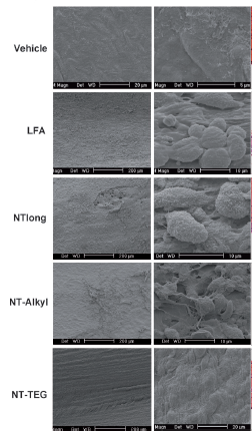
SEM images of the mice diaphragm surface 7 days after inkjection of carbone nanotubes [H. Ali-Boucettaet al., Angewandte Chemie International Edition. 52 (2013) 1-6].
The toxicity of natural mineral fibers (asbestos) and of some synthetic fibers depends on complex mechanisms including the length and the bio persistence of fibers that play a decisive role:
- the longest fibers (> 20 µm for humans) are poorly cleared from the lung by the macrophages,
- depending on their composition, the fibers are more or less well dissolved or degraded in the lung and persist for more or less time in the lungs. The longer this bio persistence is, the greater the probability that deleterious effects increase, although this is not the only factor of toxicity,
Given the carcinogenic potential of fibers, more particularly asbestos in the lungs and pleura, we can legitimately question the carcinogenicity of certain CNTs, as they may not only present characteristics similar to fibers, but also a very high mass/surface ratio and contain significant levels of metallic species that may promote oxidative stress, inflammation, or carcinogenicity.


